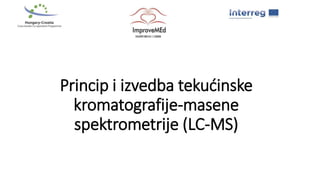Princip i izvedba tekućinske kromatografije-masene spektrometrije (LC-MS)
- 1. Princip i izvedba tekućinske kromatografije-masene spektrometrije (LC-MS)
- 2. Tekuća kromatografija - masena spektrometrija (LC-MS) • Tehnika analitičke kemije koja kombinira fizičke mogućnosti razdvajanja tekućinske kromatografije (LC) sa sposobnostima masene analize masene spektrometrije (MS) • uvedenih 1980-ih godina • može se mjeriti u jednom analitičkom postupku ^ ^ vrlo visoko osjetljiva i selektivna • korisna u mnogim aplikacijama
- 4. Tekuća kromatografija a) ulazni filter otapala, (b) crpka, (c) inline filtar otapala, (d) ventil za ubrizgavanje, (e) predkolonski filtar, (f) stup, (g) detektor, (h) snimač, (i) regulator protutlaka , (j) spremnik otpada
- 6. Masena spektrometrija Jedinica za ubrizgavanje uzorka Ionizacija Izvor Analizator mase Sustav detektora Sustav podataka Ionska generacija Analiza podataka Razvrstavanje iona prema masi (m / z) Otkrivanje • Krutina • tekući • pare
- 7. Ionizacija i suÄŤelje Elektrosprejna ionizacija (ESI) Kemijska ionizacija atmosferskog tlaka (APCI). Atmospheric Pressure Photo-ionisation (APPI) Termosprejna ionizacija(TSI) Ionizacija zrake ÄŤestica (PBI)
- 9. Ionizacija i suÄŤelje Foto-ionizacija atmosferskog tlaka Kemijska ionizacija atmosferskog tlaka (APCI)
- 11. Ionizacija i suÄŤelje Ionizacija ÄŤestica zraka(PBI)
- 12. Analizatori mase • Komponenta masenog spektrometra • uzima i odvaja ionizirane mase na temelju omjera naboj i masa • ih izlazi u detektor gdje se detektira i kasnije pretvara u digitalni izlaz. Quadrupole analizator Vrijeme analizatora leta Ionska zamka analizator Hybrid analizator
- 14. Time of Flight Analyzer Ion Trap Analyzer Analizatori mase
- 15. • Iona - električki otkrio detektor (su odvojeni prema omjer njihovih masa/naboj) • Izbor detektor temelji se na: • potrebno otkrivanje osjetljivosti i brzini • Toplinska i kemijska postojanost Detectors Najmanje osjetljiv Faraday kup detektor 1000 x veću osjetljivost u odnosu na Faradaya kup Fotomultiplikacij skom detektor Najosjetljiviji. Koristi se za visoke rezolucije Fotografski detektor
- 19. Snimanje podataka Snimanje potpunog masenog spektra - SCAN tehnika Praćenje odabranih iona - SIM tehnika Praćenje odabranih iona - SIM tehnika
- 20. Prijave Farmaceutska analiza Studije biodostupnosti Analiza produkta razgradnje lijeka Probir i karakterizacija potencijalnih lijekova Istraživanja metabolizma lijekova, farmakokinetika Identificiranje ciljeva lijeka Karakterizacija biomolekula Proteini i peptidi Oligonukleotidi Forenzička analiza Analiza okoliša Pesticidi na hrani Onečišćenje tla i podzemnih voda
Editor's Notes
-   ESI operates according to the following scheme: 1) the column effluent from the LC containing analytes is pumped through a capillary which is held at high potential (2-6 kV) and nebulized. The applied voltage can be either positive or negative, depending on the analytes; nebulization is usually assisted pneumatically (except in nanospray); 2) the droplets that detach from a tip of the capillary contain an excess of positive or negative charge as a result of the applied high voltage; 3) electrical field gradient attracts charged droplets towards the entrance of the mass spectrometer; 4) charged analyte molecules are generated from the small charged droplets either by the charged residue model or by the ion evaporation model. Ion formation from the droplets is promoted by a flow of drying gas (usually heated nitrogen); 5) the ions, solvent vapor and drying gas molecules are sampled through a capillary into a first pumping stage (0.08-0.75 Torr) where they are supersonically expanded; 6) the ions and some other neutral molecules are sampled via a skimmer into the second pumping stage (0.001-0.01 Torr) containing an ion focusing and transfer device (usually RF hexapole or octapole and a set of lenses); 7) ions enter mass analyzer region (< 10-5 Torr).
-   ESI operates according to the following scheme: 1) the column effluent from the LC containing analytes is pumped through a capillary which is held at high potential (2-6 kV) and nebulized. The applied voltage can be either positive or negative, depending on the analytes; nebulization is usually assisted pneumatically (except in nanospray); 2) the droplets that detach from a tip of the capillary contain an excess of positive or negative charge as a result of the applied high voltage; 3) electrical field gradient attracts charged droplets towards the entrance of the mass spectrometer; 4) charged analyte molecules are generated from the small charged droplets either by the charged residue model or by the ion evaporation model. Ion formation from the droplets is promoted by a flow of drying gas (usually heated nitrogen); 5) the ions, solvent vapor and drying gas molecules are sampled through a capillary into a first pumping stage (0.08-0.75 Torr) where they are supersonically expanded; 6) the ions and some other neutral molecules are sampled via a skimmer into the second pumping stage (0.001-0.01 Torr) containing an ion focusing and transfer device (usually RF hexapole or octapole and a set of lenses); 7) ions enter mass analyzer region (< 10-5 Torr).



















